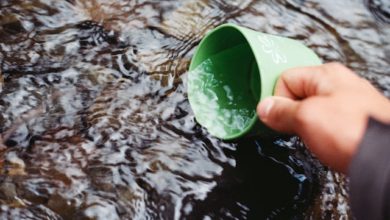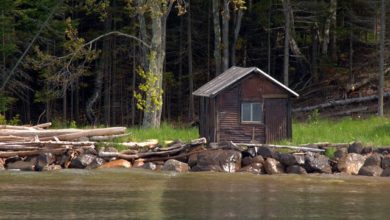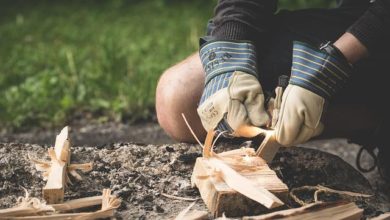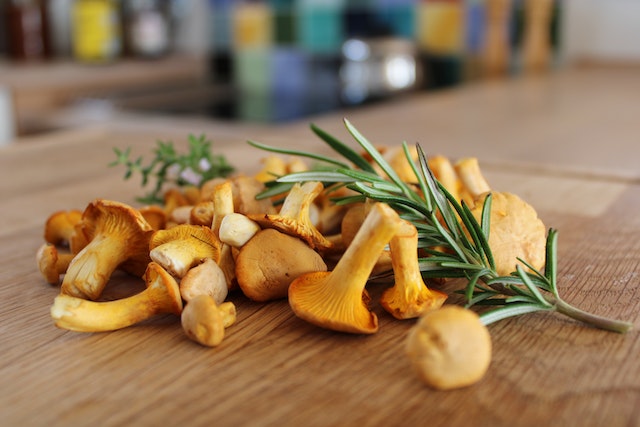
Foraging and Cooking Chanterelle Mushrooms
Foraging is one of the most important survival skills. Chanterelle mushroom is a particular type of wild fungi that we will discuss its foraging in this article.
Chanterelle mushrooms are so expensive because you cannot grow them commercially and therefore you have to forage them unlike most other commonly consumed mushrooms.
Chanterelles are easy fungi to find since they grow extensively throughout the continental U.S.
Additionally, wild chanterelle is a type of fungi that are clean and easy to cook. Apart from you gaining an added thrill by finding these mushrooms in the forest, a harbinger of early fall, they add a peppery smokiness to your dishes.
Here are some more specifics about how and where to find these tasty morsels, and what to do with them after finding them.
What Are They?
A family of mushrooms that all go under the same name of chanterelle despite them being not chanterelles are known as Chanterelles.
Golden chanterelles are specifically referred to as Cantharellus cibarius. Gomphus, Polyzellus, and Craterellus are other species that closely resemble chanterelle mushrooms therefore the name is interchangeably used.
Gill examining is one of the easiest ways to distinguish chanterelles from other, more poisonous species such as the Jack-o-Lantern mushroom in mushroom identification.
A part of the mushroom’s body that are hard to remove and it is hard to discern the perimeters of each separate gill are the chanterelle’s false gills. When you want to identify chanterelle’s false gills you spot them resembling wrinkly folds melted onto the stem and cap.
Besides, there are no rings around the base of chanterelle plus their stems are not hollow.
The aroma of the chanterelle is the final way that you can discern it from its nausea-inducing cousins. It is most likely a chanterelle if, when you pick it up and the mushroom smells faintly sweet.
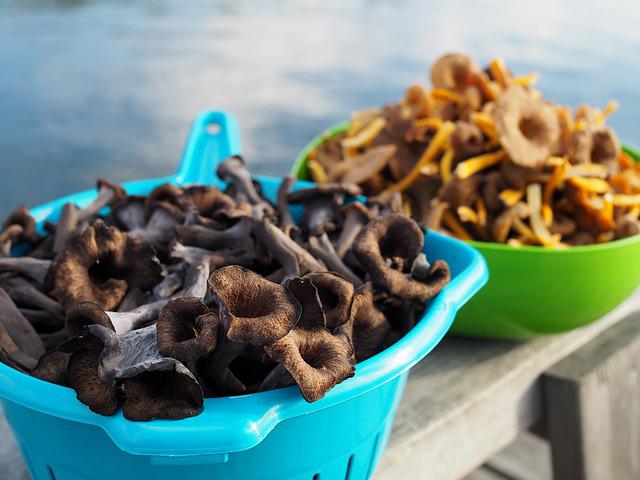
1. GOLDEN CHANTERELLES
One of the most well-known and widely sought-after types of wild mushrooms is the golden chanterelles which are also commonly referred to as orange chanterelles.
Because of the light peppery flavor of the golden chanterelles, it is mostly commended by chefs. They do provide dishes with a lovely earthly taste with a hint of almond-like nuttiness when cooked.
You can easily identify golden chanterelles since they feature a vibrant yellow or gold color and it deepens into shades of orange.
Additionally, the growing season of golden chanterelles is the green summer, and they standout against it and this also makes it easy to pick them out as a cluster. In the same fungi patch, you will often find an array of colors that range from sand to sunflower to peach.
When it comes to size, golden chanterelles can grow up to five inches in diameter but on average it should be two. Last, it features a funnel-shaped and wavy cap.
2. BLACK TRUMPETS
These mushrooms look a lot like black trumpets as the name suggests. At times black trumpets are called horns of plenty and they are also a close relative of the chanterelle.
In terms of appearance, black trumpets have thinner flesh and are more funnel-shaped compared to their golden cousins plus they are also smaller than them. However, like their golden cousin, black trumpets also feature false gills that are a telltale sign of a chanterelle.
Apart from having a smokier undertone that is akin to truffles, black trumpets have a similar bouquet and taste as golden chanterelle in terms of flavor. To infuse into oils to flavor them, some people dry and powder their black trumpets and use them as they would black truffles but it is a complex flavor.
When it comes to their availability, black trumpets have a hue that helps them blend in with shadows in the forest and therefore making them challenging to find. These mushrooms most likely return annually and therefore you should check the same locale the following year should you find a cluster.
3. CINNABAR MUSHROOMS
This is another name for red chanterelles. When it comes to appearance, cinnabar mushrooms feature perfectly formed cups plus they are tiny, brightly-hued mushrooms. In terms of size, red chanterelles are much smaller than their golden compadres since they only stand at two inches tall.
It brings to mind faerie rings and pixies when you stumble upon a cheerful cluster of these tiny beauties. Unless they find an especially abundant patch, most mushroom hunters tend not to pick them because of their size. It takes a lot of these little fungi to fill your basket but they are colorful and will liven up any dish.
WHERE AND WHEN DO THEY GROW?
Hot, humid, and damp weather are excellent for chanterelles. In hardwood forests especially near water sources, chanterelles do exceptionally well. Therefore, with the exception of Hawaii, you can find chanterelles throughout the United States.
The roots of green plants and chanterelles have a symbiotic association which makes them mycorrhizal. Because these mushrooms are mycorrhizal, cultivating them is so challenging. to gain carbohydrates and nutrition plant or tree, you will find chanterelle forming a sheath on their root tip.
You can find these particular mushrooms in some more southern states during early fall despite them loving the humid high heat of late summer. For late summer foraging for chanterelles, a perfect combination of a drenching rainstorm followed by some days of scorching heat is great.

HOW DO YOU HARVEST AND CLEAN CHANTERELLES?
A sharp knife, a pair of gardening gloves, and a basket are some of the gears that you should carry along when you are mushroom hunting.
Cutting out chanterelle is preferable for two reasons despite it being easy enough to twist. Cutting the chanterelle out will help in keeping dirt out of your basket and secondly it will help in supporting annual regeneration since the base is kept intact in the soil.
You may be tempted to stick your chanterelle in the fridge and clean them later once you get them home.
Doing this will aid in evaporating the moisture on mushrooms while the dirt is still on them as the dry air in most refrigeration units evaporates and this is a mistake that you should avoid. If you do this, it will become increasingly difficult to remove the dry dirt on the fungi.
Using a toothbrush to brush your chanterelle mushroom free of dirt in the field after breaking them in half is the easiest way to clean them.
You should eat your chanterelle mushrooms within 10 days after storing them in your fridge in a paper bag.
The lifespan of chanterelle mushrooms will be significantly shortened if you store them damp and therefore you should avoid storing them damp at all costs.
COOKING, PRESERVING, AND STORING CHANTERELLES
It can be as complex or straightforward as you would like when cooking chanterelles. Sturdy red wines such as cabernet, and wild game like rabbit or venison are some of the wide varieties of dishes that you can pair well with these mushrooms.
The Chanterelle mushroom recipe tastes lovely with chives, chervil, tarragon, and thyme.
Dehydrating and powdering chanterelle mushrooms for use as a flavoring for soups, stocks, and stews is also a great way of preserving them.
Despite some people saying that pickling chanterelle mushrooms should be reserved for the smallest and the youngest fungi, it is another excellent option for preserving them.
Sautéing in butter and then freezing the mixture in Ziplock bags is an excellent and long-term way to store your chanterelles. The defrosted mushrooms can then be added to pasta or risotto.
The Best Way to Cook Chanterelle Mushrooms
You should first sauté chanterelles over medium heat with butter and garlic for them to shine brightest.
After that, to allow your chanterelle mushroom recipe to thicken, you can add a bit of cream and parmesan cheese.
Optionally, adding in fresh oregano, a dash of lemon juice, and salt and pepper to taste can be a great way to finish things off. You will then get a creamy, yet light dish as the result and you can serve it alone or in multiple different ways as per your preference.
Final Thoughts
A great way of connecting your dining table with the world outdoors is by foraging for chanterelles in late summer or early fall. It is not just about finding something delicious to eat but also there is an added layer of satisfaction when you have foraged and found the food you are eating when you go mushroom hunting.
Take the time to check a patch of golden mushrooms out next time you spy on them in the shade of some hardwoods.
FAQs
What Is So Special About Chanterelle Mushrooms?

A favorite for many foragers is the chanterelle mushrooms because they are one of the best-tasting wild mushrooms. Apart from the anti-inflammatory benefits, fiber, minerals, vitamin D, B, and protein can be got from consuming chanterelle mushrooms.
Are Chanterelle Mushrooms Safe to Eat?
There are other mushrooms that are toxic and can cause you gastrointestinal distress if you eat them and they can be at times be mistaken for chanterelle mushrooms. However, chanterelle mushrooms are safe to eat since they are delicious and edible.
How Can You Tell Chanterelle from False Chanterelles?
While false chanterelles feature forked orange gills that can be separated, true chanterelles feature forked ridges (not true gills) that are light in color and kind of rubbery to the touch.
Additionally, forked orange gills of false chanterelles can be separated since they are deeper than those of true chanterelles and they move when stroked.
Where Is the Best Place to Find Chanterelles?
Chanterelles are associated with coniferous forests of Douglas fir and various pines in the western United States.
Rather than coniferous forests, in the east, chanterelles more commonly occur in hardwood forests. They like oaks, birch, maple, beech, and poplar in the east.
Do You Eat the Stems of Chanterelle Mushrooms?
In the forest some of the best-looking mushrooms with tops that can be cup- or trumpet-shaped are chanterelles. With edible stems that might be spindly or robust, they can grow small or large (either way, just trim off the very bottom before cooking).
Are Chanterelles Good for You?
There are around 15 different amino acids plus health-boosting polysaccharides, fatty acids, phenolic acid compounds, and beta-glucans that act as gut prebiotics.
Additionally, consuming chanterelles will add more vitamins, and minerals to your body since it is a rich source for them.
Can Chanterelles Be Eaten Raw?

Yes. There is a perceived firm, moist, fibrous texture, but merely a slight flavor when you taste a chanterelle initially. Therefore, if you have a green salad or a pizza, you can happily toss chanterelle onto it.
Should You Wash Chanterelles?
A little brushing is what cleaning chanterelles require. However, it is advisable to wash some chanterelles, especially the ones from dirty habitats.
The idea that washing mushroom washes away the flavor is nonsense and you should forget it. There are plenty of rain baths that the chanterelle in your have gone through since it took them 1 to 3 weeks to grow.
What Happens When You Eat a False Chanterelle?
There are possible side effects therefore if you are planning to cook chanterelles for a group of people it is important to be careful.
After eating false chanterelle Some people may experience mild digestive symptoms such as stomach aches and diarrhea while other individuals may experience no side effects.
What Trees Do Chanterelles Grow Under?
Hardwood forests are chanterelles’ most preferred habitat because they form a symbiotic relationship with the roots of trees since they are mycorrhizal.
Some of the favorite hardwood trees that chanterelle mushrooms prefer include oak, maple, poplar, and birch. You can also find these mushrooms growing around white pine.
Do You Refrigerate Chanterelles?
The refrigerator is a great place to store your chanterelle mushrooms. To let these mushrooms breathe when refrigerating them, you should place them in a paper bag or a bowl loosely covered with a paper towel.
Once refrigerated, you should consume them within 10 days. Consequently, you should discard your chanterelle mushrooms should they turn slimy during refrigeration.
How Many Weeks After a Big Rain Will You Find Chanterelles?
After heavy rainfall in hot, humid weather, the best time to search begins in 2-3 days. However, if it keeps raining, you can continue to two to three more weeks.
Apart from Hawaii, chanterelle mushrooms grow in every state and therefore making them among the easiest wild mushrooms to identify.
What Time of The Year Do Chanterelles Come Out?
The most productive season for chanterelles is fall and winter. However, in areas of coastal fog drip, they can appear through the spring and even in summer.
The formation of numerous primordia, knots of tissue representing chanterelles in miniature by mushroom mycelia can be stimulated by early rains.
How Do You Tell When Chanterelles Are Done Cooking?
Chanterelles will be very firm and almost have a squeaky cheese quality to them, firm and chewy before the caps have become wavy and thin especially when they are still young.
How Do Chanterelles Taste?
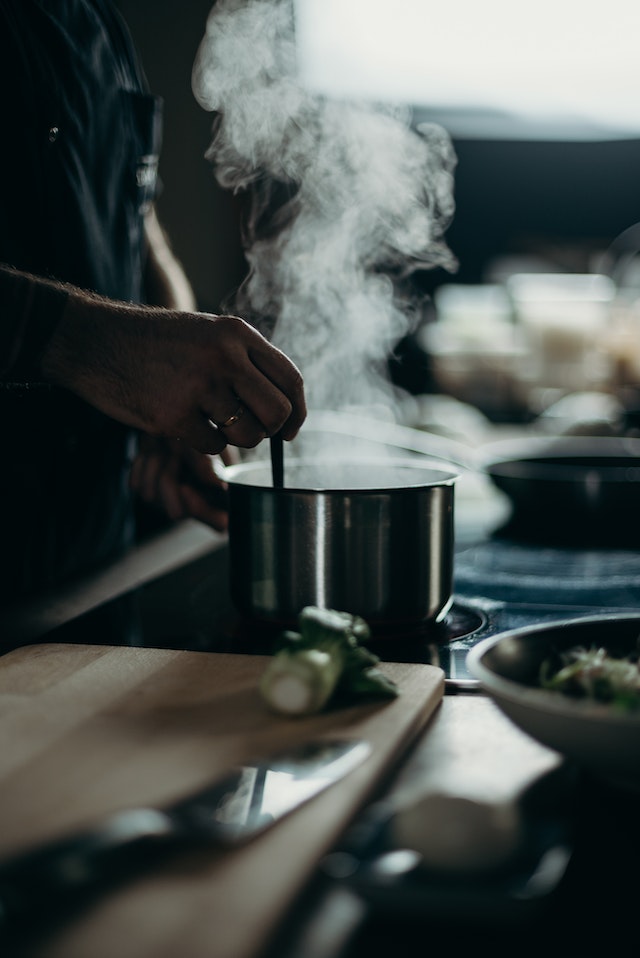
Around the globe, the most common edible wild mushrooms are the golden buttery yellow, chanterelle mushrooms. Compared to other mushrooms, chanterelles feature a very unique flavor.
Apart from having a hint of apricot or peach flavor, without the sweetness, of course, chanterelles are slightly fruity.
Do Chanterelles Have Medicinal Properties
An edible mushroom with medicinal value is the golden chanterelle mushroom, Cantharellus cibarius.
Strong antioxidant potential, bactericidal effects, and excellent radical scavenging are some of the medicinal values of the golden chanterelles mushroom.
Do Chanterelles Have Protein?
The is a small amount of protein at the rate of o.8 grams per every single serving cup in chanterelles mushrooms. Chanterelles mushrooms provide all of the essential amino acids, despite not being a substantial source of this macronutrient.
What Vitamins Do Chanterelles Have?
Apart from being a good source of antioxidants, which are essential in promoting your immune and health function, chanterelles are considered versatile and nutritious. Vitamins B, copper, and vitamin D are fiber are some of the nutrients in these mushrooms.
